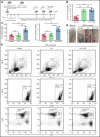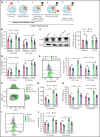Soluble uric acid inhibits β2 integrin-mediated neutrophil recruitment in innate immunity
- PMID: 35303071
- PMCID: PMC11022987
- DOI: 10.1182/blood.2021011234
Soluble uric acid inhibits β2 integrin-mediated neutrophil recruitment in innate immunity
Abstract
Neutrophils are key players during host defense and sterile inflammation. Neutrophil dysfunction is a characteristic feature of the acquired immunodeficiency during kidney disease. We speculated that the impaired renal clearance of the intrinsic purine metabolite soluble uric acid (sUA) may account for neutrophil dysfunction. Indeed, hyperuricemia (HU, serum UA of 9-12 mg/dL) related or unrelated to kidney dysfunction significantly diminished neutrophil adhesion and extravasation in mice with crystal- and coronavirus-related sterile inflammation using intravital microscopy and an air pouch model. This impaired neutrophil recruitment was partially reversible by depleting UA with rasburicase. We validated these findings in vitro using either neutrophils or serum from patients with kidney dysfunction-related HU with or without UA depletion, which partially normalized the defective migration of neutrophils. Mechanistically, sUA impaired β2 integrin activity and internalization/recycling by regulating intracellular pH and cytoskeletal dynamics, physiological processes that are known to alter the migratory and phagocytic capability of neutrophils. This effect was fully reversible by blocking intracellular uptake of sUA via urate transporters. In contrast, sUA had no effect on neutrophil extracellular trap formation in neutrophils from healthy subjects or patients with kidney dysfunction. Our results identify an unexpected immunoregulatory role of the intrinsic purine metabolite sUA, which contrasts the well-known immunostimulatory effects of crystalline UA. Specifically targeting UA may help to overcome certain forms of immunodeficiency, for example in kidney dysfunction, but may enhance sterile forms of inflammation.
© 2022 by The American Society of Hematology.
Figures









Comment in
-
Hyperuricemia reduces neutrophil function.Blood. 2022 Jun 9;139(23):3354-3356. doi: 10.1182/blood.2022016275. Blood. 2022. PMID: 35679075 No abstract available.
Similar articles
-
Soluble Uric Acid Is an Intrinsic Negative Regulator of Monocyte Activation in Monosodium Urate Crystal-Induced Tissue Inflammation.J Immunol. 2020 Aug 1;205(3):789-800. doi: 10.4049/jimmunol.2000319. Epub 2020 Jun 19. J Immunol. 2020. PMID: 32561569
-
Molecular Insights Into Neutrophil Biology From the Zebrafish Perspective: Lessons From CD18 Deficiency.Front Immunol. 2021 Sep 7;12:677994. doi: 10.3389/fimmu.2021.677994. eCollection 2021. Front Immunol. 2021. PMID: 34557186 Free PMC article.
-
Genetic and Epigenetic Regulation of the Innate Immune Response to Gout.Immunol Invest. 2023 Apr;52(3):364-397. doi: 10.1080/08820139.2023.2168554. Epub 2023 Feb 6. Immunol Invest. 2023. PMID: 36745138 Review.
-
Uric acid induces NADPH oxidase-independent neutrophil extracellular trap formation.Biochem Biophys Res Commun. 2014 Jan 10;443(2):556-61. doi: 10.1016/j.bbrc.2013.12.007. Epub 2013 Dec 8. Biochem Biophys Res Commun. 2014. PMID: 24326071
-
Intracellular β2 integrin (CD11/CD18) interacting partners in neutrophil trafficking.Eur J Clin Invest. 2018 Nov;48 Suppl 2:e12966. doi: 10.1111/eci.12966. Epub 2018 Jun 29. Eur J Clin Invest. 2018. PMID: 29896791 Review.
Cited by
-
Asymptomatic hyperuricaemia in chronic kidney disease: mechanisms and clinical implications.Clin Kidney J. 2023 Jan 10;16(6):928-938. doi: 10.1093/ckj/sfad006. eCollection 2023 Jun. Clin Kidney J. 2023. PMID: 37261000 Free PMC article. Review.
-
Neutrophils-biology and diversity.Nephrol Dial Transplant. 2024 Sep 27;39(10):1551-1564. doi: 10.1093/ndt/gfad266. Nephrol Dial Transplant. 2024. PMID: 38115607 Free PMC article. Review.
-
Gout and Excess Risk of Severe SARS-CoV-2 Infection Among Vaccinated Individuals: A General Population Study.Arthritis Rheumatol. 2023 Jan;75(1):122-132. doi: 10.1002/art.42339. Epub 2022 Nov 30. Arthritis Rheumatol. 2023. PMID: 36082457 Free PMC article.
-
Nuclear receptor 4A1 is critical for neutrophil-dependent pulmonary immunity to Klebsiella pneumoniae infection.Front Immunol. 2025 Mar 6;16:1558252. doi: 10.3389/fimmu.2025.1558252. eCollection 2025. Front Immunol. 2025. PMID: 40114913 Free PMC article.
-
Chronic kidney disease.Nat Rev Dis Primers. 2025 Jan 30;11(1):8. doi: 10.1038/s41572-024-00589-9. Nat Rev Dis Primers. 2025. PMID: 39885176 Review.
References
-
- Liew PX, Kubes P. The neutrophil's role during health and disease. Physiol Rev. 2019;99(2):1223–1248. - PubMed
-
- Németh T, Sperandio M, Mócsai A. Neutrophils as emerging therapeutic targets. Nat Rev Drug Discov. 2020;19(4):253–275. - PubMed
-
- Amulic B, Cazalet C, Hayes GL, Metzler KD, Zychlinsky A. Neutrophil function: from mechanisms to disease. Annu Rev Immunol. 2012;30(1):459–489. - PubMed
-
- Mayadas TN, Cullere X. Neutrophil beta2 integrins: moderators of life or death decisions. Trends Immunol. 2005;26(7):388–395. - PubMed
Publication types
MeSH terms
Substances
LinkOut - more resources
Full Text Sources

